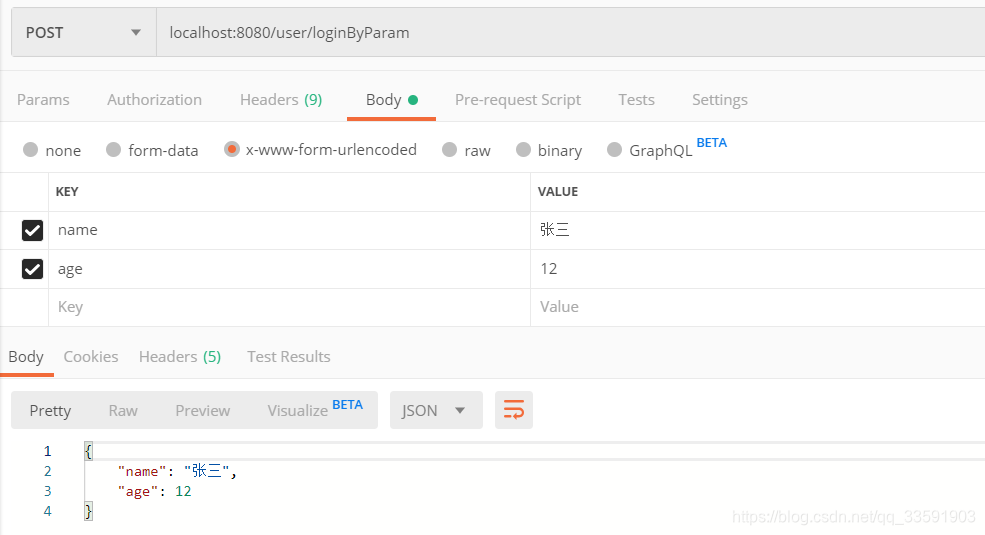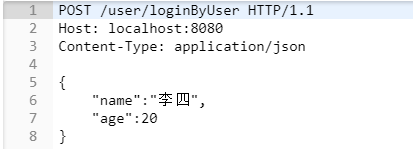文章目录
- Content-Type详解
- Content-Type是什么?
- Content-Type的格式
- Post请求中常见的Content-Type类型的结构
- SpringBoot中如何根据Content-Type解析数据
- 一、接收get请求
- 二、接收Post请求
- 总结:
Content-Type详解
Content-Type是什么?
在HTTP协议消息头中,使用Content-Type来表示媒体类型信息。它被用来告诉服务端如何处理请求的数据,以及告诉客户端(一般是浏览器)如何解析响应的数据,比如显示图片,解析html或仅仅展示一个文本等。
Post请求的内容放置在请求体中,Content-Type定义了请求体的编码格式。数据发送出去后,还需要接收端解析才可以。接收端依靠请求头中的Content-Type字段来获知请求体的编码格式,最后再进行解析。
Content-Type的格式
Content-Type:type/subtype ;parameter
type:主类型,任意的字符串,如text,如果是号代表所有;
subtype:子类型,任意的字符串,如html,如果是号代表所有,用“/”与主类型隔开;
parameter:可选参数,如charset,boundary等。
例如:
- Content-Type: text/html;
- Content-Type: application/json;charset:utf-8;
- Content-Type: application/x-www-form-urlencoded;charset:utf-8;
Post请求中常见的Content-Type类型的结构
(1)application/x-www-form-urlencoded
这是浏览器原生的form表单类型,或者说是表单默认的类型。
下面是一个请求实例:

请求报文:

可以看得出,post将请求参数以key1=value1&key2=value2这种键值对的方式进行组织,并放入到请求体中。其中中文或某些特殊字符,如"/“、”,“、“:” 等会自动进行URL转码。
(2)application/json
现在绝大部分的请求都会以json形式进行传输,post会将序列化后的json字符串直接塞进请求体中。
下面是一个请求实例:

请求报文:(postman查看请求报文,点击Send下面一行的code,然后点击HTTP即可)

可以看到,请求体中就是Json字符串。
(3)multipart/form-data
用于在表单中上传文件,先看一个请求实例:
请求报文:

可以看得出,首先随机生成了一个boundary字段,这个boundary用来分割不同的字段。
一个请求的参数,会以boundary开始,然后是附加信息(参数名称,文件路径等),再空一行,最后是参数的内容。
请求体最后再以boundary结束。
当然,response中也会有Content-Type为multipart/form-data的响应头。如果此时是导出文件,则响应头还需要添加一个
Content-Disposition:attachment;fileName=文件.后缀
注:Content-Disposition是Content-Type的扩展,告诉浏览器弹窗下载框,而不是直接在浏览器里展示文件。因为一般浏览器对于它能够处理的文件类型,如txt,pdf 等,它都是直接打开展示,而不是弹窗下载框。
SpringBoot中如何根据Content-Type解析数据
首先定义一个User实体类:
@Data
class User {String name;int age;User() {}User(String name, int age) {this.name = name;this.age = age;}
}
一、接收get请求
(1)后端用实体类接收
@GetMapping("/loginByUser")public User loginByUser(User user) {return user;}
前端则调用url:localhost:8080/user/loginByUser?name=tom&age=12
(2)后端用参数接收
@GetMapping("/loginByParam")public User loginByParam(@RequestParam("name1") String name,@RequestParam(value = "age", required = true, defaultValue = "20") int age) {return new User(name, age);}
前端则调用url:localhost:8080/user/loginByParam?name1=tom
@RequestParam注解将请求参数绑定到方法参数上。它有以下3个常用参数
- value:用来声明请求参数中的参数名称。例子中将请求参数中的name1绑定到方法参数中的name字段。
- required:当没声明其required时,默认是true。即如果前端没传入name1的话,后端则会报错。
- defaultValue:当age参数的required=true时,而前端又没有传入这个参数时,则参数列表中的这个age将会有一个默认值。
此时情况下的@RequestParam注解,可加可不加。
(3)后端使用Map接收
@GetMapping("/loginByMap")public User loginByMap(@RequestParam Map<String, Object> map) {String name = (String) map.get("name");int age = Integer.parseInt((String) map.get("age"));return new User(name, age);}
前端则调用url:localhost:8080/user/loginByMap?name=tom&age=12
值得注意的是,这里的map参数前需要加@RequestParam注解,用于将请求参数注入到map中。
(4)后端用路径接收
@GetMapping("/loginByPath/{name}/{age}")public User loginByPath(@PathVariable("name") String name, @PathVariable("age") int age) {return new User(name, age);}
前端则调用url:localhost:8080/user/loginByPath/tom/12
@PathVariable注解用于将路径中的参数绑定到方法参数中
(5)后端用数组接收
@GetMapping("/array")public Integer[] array(Integer[] a) {return a;}
前端则调用url:localhost:8080/user/array?a=1&a=2&a=3
当然,这里也可用List来接收,不过需要加上@RequestParam(“a”)注解
如果直接使用List来接收,也不加上@RequestParam(“a”)注解的话,则会报错
No primary or default constructor found for interface java.util.List
二、接收Post请求
(1)后端使用实体类进行接收,前端传入Content-Type:application/json格式的数据
@PostMapping("/loginByUser")public User loginByUser(@RequestBody User user) {return user;}
@RequestBody注解用于将请求体中的json字符串转化为java对象。
值得注意的是
- 由于get无请求体,那么@RequestBody不能使用在get请求上。
- @RequestBody与@RequestParam可以同时使用,@RequestBody最多只能有一个,而@RequestParam可以有多个。
如果这里的User对象,只有一个参数,比如name。那么这里也可以直接这样接收
@PostMapping("/loginByUser")public User loginByUser(@RequestBody String name) {return user;}
postman传参则直接这样传参

但其实并不推荐这样,一个参数也是可以用get传参的。
(2)后端使用实体类进行接收,前端传入Content-Type:application/x-www-form-urlencoded格式的数据
@PostMapping("/loginByUser")public User loginByUser(User user) {return user;}
Content-Type:application/x-www-form-urlencoded格式的数据,数据会以key/value格式进行传输,SpringMvc会直接将请求体中的参数直接注入到对象中。
(3)后端使用参数进行接收,前端传入Content-Type:application/x-www-form-urlencoded格式的数据
@PostMapping("/loginByParam")public User loginByParam(@RequestParam("name1") String name,@RequestParam(value = "age", required = true, defaultValue = "20") int age) {return new User(name, age);}
此时的@RequestParam注解加不加都无所谓
(4)后端使用Map来接收,前端传入Content-Type:application/x-www-form-urlencoded格式的数据
@PostMapping("/loginByMap")public User loginByMap(@RequestParam Map<String, Object> map) {String name = (String) map.get("name");int age = Integer.parseInt((String) map.get("age"));return new User(name, age);}
这里类似于get请求的(3),同样,map参数前需要加@RequestParam注解,用于将请求参数注入到map中。
值得注意的是,由于form表单形式是以key/value形式存储,都是字符串类型,因此需要将map.get(“age”)转化为String,再转化为Integer,最后再自动拆箱。
不可以将map.get(“age”)直接转化为Integer类型,因为其本质是String类型,String不能直接强转为Integer。
(5)后端使用Map来接收,前端传入Content-Type:application/json格式的数据
@PostMapping("/loginByMap")public User loginByMap(@RequestBody Map<String, Object> map) {String name = (String) map.get("name");int age = (Integer) map.get("age");return new User(name, age);}这里类似于post请求的(1),同样,@RequestBody注解用于将请求体中的json字符串转化为对象属性,并注入到map中。
由于请求体中json中的age类型为number类型,因此注入到map中时,age是Integer类型,那么可以直接强转为Integer类型。
(6)后端使用JSONObject来接收,前端传入Content-Type:application/json格式的数据
@PostMapping("/loginByJSONObject")public User loginByJSONObject(@RequestBody JSONObject jsonObject) {String name = jsonObject.getString("name");int age = jsonObject.getInteger("age");return new User(name, age);}
@RequestBody注解用于将请求体中的json字符串转化为JSON对象。
(7)后端使用数组来接收
@PostMapping("/array")public Integer[] array(Integer[] a) {return a;}
前端传入Content-Type:application/x-www-form-urlencoded格式的数据,后端可以直接接收到。如图

但传入Content-Type:application/json格式的数据[1,2,3],后端则接收不到,需要加入@RequestBody注解。
当然(@RequestBody List a)也是可以的。
总结:
@PathVariable、@RequestParam与@RequestBody注解三者的区别
| 注解 | 支持的类型 | 支持的请求类型 | 支持的Content-Type | 请求示例 |
|---|---|---|---|---|
| @PathVariable | url | GET | 所有 | /test/{id} |
| @RequestParam | url | GET | 所有 | /test?id=1 |
| Body | POST/PUT/DELETE/PATCH | form-data或x-www.form-urlencoded | id:1 | |
| @RequestBody | Body | POST/PUT/DELETE/PATCH | json | {“id”:1} |
如果前端传入Content-Type:application/json格式的数据,直接使用@RequestBody注解将json字符串转化为对象。
如果前端传入Content-Type:application/x-www-form-urlencoded格式的数据,如果能够得出方法参数具有的属性和请求参数一样的属性时,则不需要@RequestParam注解。例如注入到Map中,则需要@RequestParam注解。
如果后端已经使用了@RequestBody注解,代表只接收application/json类型的数据,此时若再传入application/x-www-form-urlencoded类型的数据,则后台会报错
“status”: 415,
“error”: “Unsupported Media Type”,
“message”: “Content type ‘application/x-www-form-urlencoded;charset=UTF-8’ not supported”
另外,get请求的请求头没有Content-Type字段。




,format(),charAt(),indexOf(),substring(),compareTo(),split(),replaceAll)










Collectors.collectingAndThen 去重Stream分组groupBy后取单一字段值、取列表第一个值方式)



